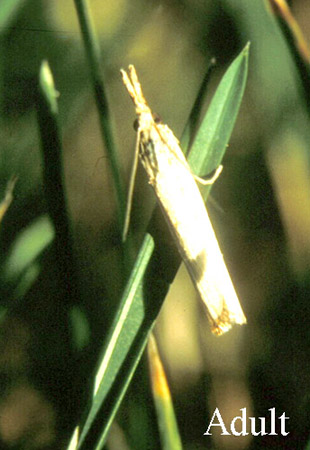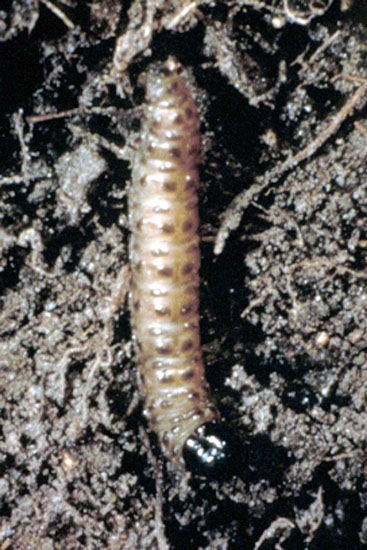Issue 12, July 16, 2010
Sod Webworms
High numbers of sod webworm adults have been noticed around lights and in light traps. There are several species of sod webworms that are damaging to turf, but the adult moths look similar. They have light tan wings that are held tight against the body, giving the body a tube-like appearance. Their mouthparts have long palps that protrude beyond the front of the head, giving their taxonomic family the common name, snout moths. The species vary in size from one-half inch to about one inch long, and some species have whitish or brown stripes on their wings.

When these moths are disturbed during the day in turf, they fly low to the ground, no higher than your head, in a jerky fashion. They do not fly very far, settling back down onto the turf within about 30 feet of where they were disturbed. The most common species, the larger sod webworm, tends to sit crosswise on the grass blade when at rest. Other species sit lengthwise on the grass blades.
Eggs are dropped into the turf as the adult moths fly across it. The resulting larvae live in a silk-lined tunnel in the thatch during the day, coming out at night to clip off and eat the grass blades.
Small balls of green fecal pellets are common around the crowns of infested turf. The larvae are slender with dark brown spots. Their base color varies from whitish to gray to tan to green depending on the species and the larval feeding activity. Fully-grown larvae of the larger sod webworm are about one inch long. Other species are similar in size or smaller.

Damage will first appear as indistinct brown patches of turf. Close examination will reveal that most of the grass blades are missing with the thatch causing the brown appearance. The turf will be firmly rooted. As infestations progress, entire lawns can turn brown.
Sod webworm caterpillars are controlled naturally by microsporidia, microscopic one-celled organisms somewhat similar to bacteria and fungi. Like fungi, microsporidia are more active when there is plenty of moisture. The microsporia typically keep the sod webworm numbers too low to cause significant damage in irrigated turf and in years with periodic, adequate rainfall.
Unwatered turf in areas with drought are likely to experience high amounts of sod webworm larval damage. If unattended, large turf areas are likely to die. If infestations are noticed early and promptly treated, the intact root system will quickly replace the eaten grass blades, resulting in quick recovery of the turf's appearance.
Sod webworms are easily controlled with a large number of insecticides. Effective, labeled products include bifenthrin (Onyx, Talstar), carbaryl (Sevin), chlorantroniliprole (Acelepryn), clothianidin (Arena), deltamethrin (Delta Gard), indoxacarb (Provaunt), lambda-cyhalothrin (Scimitar), trichlorfon (Dylox), spinosad (Conserve), and Steinernema carpocapsae (Biosafe). The last two are considered to be organic. Allow the spray to dry on the grass blades.--Phil Nixon
Author:
Phil Nixon